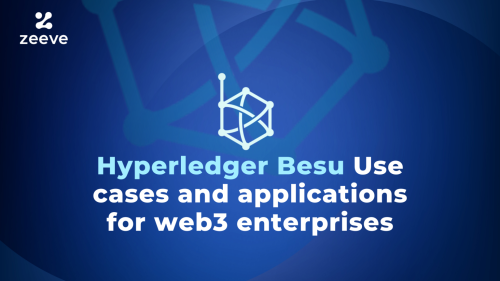
Top Reasons Why Enterprise Blockchain Projects Fail And How To Circumvent Them
Blockchain is a distributed ledger technology that features data immutability, decentralization, and peer-to-peer communication. It helps to build trust-less networks for businesses to transact with other organizations. In the enterprise domain where trust is expensive, Blockchain helps organizations weed out inefficiencies both within the enterprise as well as industry-wide.
During 2017–2019, businesses mostly spent on trying out the technology with Proofs-of-Concept and Pilots. Today, Blockchain is getting into the mainstream with the launch of large Blockchain networks and consortia like IBM Food Trust, TradeReboot, Zuron, etc. The question among the enterprise leadership is no more about whether the Blockchain technology will work? It is about how can we make it work for us?
While many folks have invested in enterprise Blockchain projects, the reality is that many of these projects do not make it beyond proof-of-concept. As per a report published by Gartner, only 5% make it to production, and 90% of them will need replacement within two years to stay abreast in the competition. Most of them have either ignored or are no longer interested in making any significant change on the spot. So, what has failed for them? There are some common mistakes as to why these enterprise Blockchain systems failed. However, the most common one is a misunderstanding of the Blockchain applications in the real world.
Trying to Apply Blockchain to Everything
While Blockchain technology can disrupt most industries, it is not a solution to every problem. Besides, the technology is still maturing, so it is unsurprising that not everyone understands it or knows its use cases. Businesses should first figure out if their business needs Blockchain instead of implementing it straight away. There are two ways to find that out:
- Is the legacy solution ineffective, insecure, or expensive? — Developing and deploying a Blockchain-based solution only makes sense when the legacy system is proven to be inadequate.
- Do you have trusted sources to fetch high-quality digital data? — As Blockchains stores data immutably, it is essential to have trustworthy sources that can feed correct data to the Blockchain ledger.
If the answer to these two is yes, a business can certainly benefit from Blockchain technology. However, it is equally important to consider three interconnected areas, including scalability, costs, and complexity.
- Scalability is imperative to evaluate the volume of on-chain transactions required by the proposed use cases. If an existing protocol cannot process the required volume, there’s a good chance that a business is not ready for Blockchain technology.
- Blockchain is a complex technology that not only requires expertise but also needs businesses to integrate data from trusted sources. Smart contracts implementation is another head-scratching task.
- The cost incurred in developing and deploying Blockchain technology into a business can be huge. It does not apply to only the manpower but also the hardware and technical resources. If adding new nodes is too expensive, a business is possibly not ready for Blockchain implementation.
Lack of Incentives
People work when they can gain something. Most of the firms get this wrong, and they put technical design ahead of economic design. Digital heads accord less priority to users’ incentives and product value. Instead, businesses prioritize hiring top-class technical talent. It is crucial to understand that Blockchain systems are economic systems and they are as valuable as technical systems. Another reason for the failure of most enterprise Blockchain systems is the fundamental misunderstanding of the Blockchain’s economics and the means to creating long-term monetization. Like social media platforms, Blockchain systems derive most of their value from their users. Therefore, firms should understand the network effects of initial use cases and then line them up with the early user base.
Lack of Governance
The governance mechanism of an Enterprise Blockchain system is perhaps the greatest predictor of a business’s success. While many institutions know what Blockchain governance is and how to best implement it, achieving this goal in the real-world is, at times, more challenging than estimated. Blockchain governance requires consensus achieved between users on the network in addition to the consensus accomplished by validators. Projects like MakerDAO and DASH were the two of the first few projects that aim to harness a “governance model” to diversify trust in trust-less ecosystems. While some might argue that Bitcoin doesn’t have any governance but is still a successful project, others suggest that if Bitcoin had a healthy governance system, it would have been more successful than it has been.
If you are getting into a Blockchain consortium, the governance structure becomes very important. Typically, in the Blockchain consortia, the competitors of an industry come together and takes collaborative approach. So, having a proper governance structure becomes all the more important. Various early consortia could not sustain themselves because of the lack of proper governance structure and incentive mechanisms.
Lack of Regulatory Clarity
As with other innovative technologies, Blockchains also struggle with regulatory challenges as the proper regulatory framework is not in place. Besides, regulations have always struggled to keep with the emerging tech space. “It is a revolution because Blockchains can record identities, financial transactions and all kinds of legal operations”, says tech guru Chris Skinner. Whether it be legal validity about identities stored on the Blockchain or transactions executed by smart contracts, a legal and regulatory framework is required.
One interesting use case is the use of Blockchain as a valid regulatory registry for the Internet of Things. In IoT, all connected devices have an identity, and Blockchain can act as a shared registry of such identities and enable secure device-to-device transactions. Now, this would necessitate a legal framework recognizing distributed ledgers as valid regulatory registries.
Blockchain is “Database” Mentality
The advent of Blockchain technology has led to the creation of the Distributed Ledger Technology or Web 3.0 world. Even so, most enterprises who adopt DLT do so thinking they’re deploying traditional databases. As for now, Blockchains can store only limited amounts of data on-chain, which include transactions that are recorded on the ledger. In no way, these ledgers should be considered a database to store data. It simply won’t work. So, a sound architecture needs to be designed for a decentralized application. There should be an ideal combination of on-chain and off-chain data design. This helps in achieving desired performance without compromising on security, privacy, or large data-sets.
Lack of Blockchain Expertise in Enterprises
As mentioned earlier, Blockchain systems enable value exchange and require sound architecture. This entails knowledge about programming languages (specialized in some cases like Ethereum), incentive mechanisms, cryptography, smart contracts, governance, and tokenomics. This unique skill-set is quite different from the traditional application requirements. A poorly designed Blockchain application will fail to deliver the expected value.
Legacy System Challenges
The enterprise Blockchain applications do not work single-handedly. Rather, the legacy systems, applications, and data-sets need to integrate seamlessly. It is a complex exercise as the demands for traditional and distributed systems are different. Besides, while working with some organizations like banks or hospitals, they must adhere to compliance. If the integration is not seamless, it will lead to issues, such as data inconsistency, poor user experience, cost overheads, and poor performance.
Poorly defined KPIs
The Blockchain applications operate on a decentralized network with stakeholders from within and outside the organization. Thus, the success parameters need to be properly defined for a Blockchain system. Some of the Key Performance Indicators (KPIs) could be transaction cost, throughput, growth in the no of stakeholders leading to the network effect, user experience, etc. The KPIs should also align with the business objectives. For example, while working on a trade finance use case, the parameters like time reduced to complete a transaction, the number of documents reduced, and several disputes reduced become important.
Enterprise Blockchain Adoption — Way Forward
While many enterprise Blockchain systems have failed in the past, some have revolutionized the industry through the ideal use of Blockchain technology. Indubitably, the technology holds the potential to disrupt every space, from banking to supply chain and healthcare to voting systems. As per Deloitte’s 2020 Global Blockchain Survey, 55% of the surveyed businesses said Blockchain is a top-five strategic priority, 39% already have Blockchain application in production, and 82% are either hiring staff with Blockchain expertise or plan to within the next 12 months. 85% of the respondents believe their suppliers, customers, and/or competitors are working on Blockchain solutions to address current challenges in the value chain.
To unlock the value and promise of Web 3.0, the adoption of Blockchain in enterprises needs to be accelerated. To circumvent the challenges mentioned above, the organizations need to articulate a sound adoption strategy that includes implementing the right tools and partnering with the right partners. Zeeve has been at the forefront of the enterprise Blockchain adoption, and we have helped many organizations conceptualize and implement Blockchain Technology. Zeeve’s Blockchain as a Service platform supports faster development of decentralized applications through a rich set of ready-to-deploy services and APIs, manages CI/CD pipelines, provides automated deployments of Blockchain nodes and networks, and monitors the Blockchain infrastructure. Zeeve helps save more than 60% in costs and time to market.






Responses